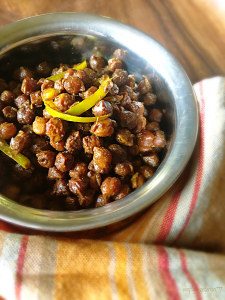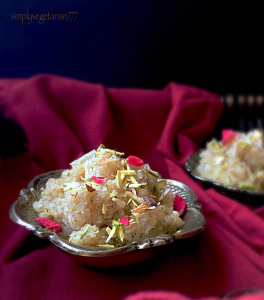Basic Guidelines to Performing Ashtami/Navami Kanjak Pooja
As an Amazon Associate and member of other affiliate programs, I earn from qualifying purchases.

Basic Guidelines to Performing Ashtami/Navami Kanjak Pooja

{Image Source – Google Images}
Disclaimer 1 – The mentioned article Basic Guidelines to Performing Ashtami/Navami Kanjak Pooja is created by me, keeping in mind how I have observed the Ashtami & Navami Pooja in my mother’s and mother-in-law’s home.
Disclaimer 2 – It is an unbiased article and describes a basic guideline to those who want to follow it. Different parts of the country, follow different traditions. Please consult with your elders at home, for any affirmations and confirmations.
To observe Kanjak Pooja, refer to these 2 recipes of Sookhe Kale Chane & Sooji ka Halwa, which is mandatory as a Prasad.
For the recipes, click on the pictures.


Navratri celebrates the 9 avatars of Divine Mother Durga. Kanjak Or Kanya Poojan is an important ritual that is followed to culminate the Navratri Celebration. Little Girls are worshipped, fed with “Saatvik Bhojan” and then they are sent back home with gifts. In return these little “Durga Avatars” bless the people, who invite them.
Kanjak is celebrated on either the 8th day or the 9th day of the Navratri. Every family has their own tradition. Some follow Ashtami (8th day) and some follow Navami (9th day). In the state of Uttar Pradesh, where I belong to, we observe Kanya Langde. Kanya means girl and Langde means Boy. So we often worship little boys also along with girls since Mata Rani is always seen with her male followers.
Here is a step by step guide on how to observe the Kanjak Poojan. I will also mention towards the end, some adaptations for the convenience to match our busy lifestyles. Therefore, a request to read along.
Who should be worshipped ?
- The little girls who have not hit the puberty yet, are worshipped.
-
Anywhere from 5 to 9 little girls are worshipped.
-
In the absence of all girls, little boys can be added for Poojan. Atleast in Uttar Pradesh, my family follows it. Please consult your elders in the family, if your families have strong Dos and Don’ts.
How to perform the Poojan ?
- It is often observed during the day time. Often a brunch or early lunch is served to the little girls.
-
The ladies and men of the house take a bath early in the morning and wash their heads. Cleanse and sanitize the kitchen. Then the “Saatvik Bhoj” is cooked. It comprises of Poori, Halwa and Sookhe Kaale Chane!
-
Athavari – This is the offering prepared as Prasaad to Ma Durga. 8 Pooris are stacked together and a bit of halwa and Kaale Chane are placed on top of it. Some money is kept too.
-
The Durga idol or picture is worshipped. The Durga Arti is sung. The Athavari is offered to Ma Durga and that becomes Prasad then to be fed to the little girls. A small bite of poori, halwa and Chane from the Athavari is offered in the agnee lit in front of the Devi.
-
The little girls are invited. They are seated on the ground in a line (pankti/pangat).
-
The ladies and men wash their tiny feet in a big bowl (paraat) of water. Then dry their feet.
-
Put kumkum or Roli Chawal teeka/Bindi on their foreheads.
-
Tie the mauli/kalawa (red colored holy thread) on their tiny right hands.
-
Offer the Arti to them in clockwise direction.
-
Bow to them. Touch their feet. Seek for their blessings.
-
Serve them the food. Feed them with love and devotion.
-
Then give them gifts before sending them back home. Look for gift item suggestions in the different heading below.
What to feed the Little Durgas?
- A trio of Poori, Suji ka Halwa and Sookhe Kale Chane is mandatory, as per tradition. Normally that is what is kept in Durga Poojan and then fed to the kids. Normally 2 to 5 Pooris are kept per child.
-
In the busy lifestyles and in the shortage of finding time or age appropriate children, people have adapted the prasad. You may prepare small ziplock or packets of fruits like apples and bananas, egg-free biscuits, egg less cookies and muffins, juice boxes etc. It is totally fine till your Bhav or emotion is pure and good!
-
If you cannot find the 7 to 9 age appropriate kids in your home or neighborhood, you may give it in the temple or the best would be to feed the poor and hungry.
What kind of Gifts are considered?
- Traditionally, singaar ka samaan like bangles, bindi and chunri are given to the little girls.
-
If you want to adapt to it then you may consider some age appropriate games, puzzles, pens, colors, story books, notepads, dolls, frisbee, jumping ropes, etc. I would rather give them something useful and budget friendly. Gifting should be a humble gesture and not how big and pompous you can be than others.
-
I have observed that some cash is always given to the kids. You may choose the amount to your desire. It is more of a token.
I hope that the article was useful and helpful to many who are either following it for the first time or have nobody to guide them.
A very happy Kanjak to all the lovely people out there!! Let us spark the love and respect towards the girl child and bring back the Little Durgas in our lives with dignity and rightfulness.
I hope the above article about Basic Guidelines to Performing Ashtami/Navami Kanjak Pooja was useful for you.
Bringing the grand celebrations from my Indian American Home to yours!
Sonal

very informative and helpful
thanks for sharing traditional and modern way
I enjoy reading your post blog. It was very informative and especially when we’re away from home. Thank you so much for your diligent efforts and recipes. Please continue to post India’s Tradition so it will continue for new generations to come. Take care. “Jai Mata De!”
Can unmarried girls organise kanyapujan on their own?
Every family is different so you should ask elders of your family.
Awesome, thanks for the information.
Lovely share Sonal. I do it the same way. 🙂
thanks Ruchi 🙂
A lovely post!
Very interesting Sonal! I love the idea that these children are made to feel special and are appreciated. What a self-esteem booster.
Have such fond memories from my childhood Julie! ❤️
awesome Sonal
Thanks
Got lots of info. Thanks!
Bahut hi badiya .. Very nicely explained… Well done dear!!
Thank you so much Swati! Your confirmation means a lot!!
Can we have 3 kanjaks if we can’t find more? It is indeed difficult during Covid times:(
Normally it is 5 and more. But I believe in you do what you can do and leave the rest to the God.